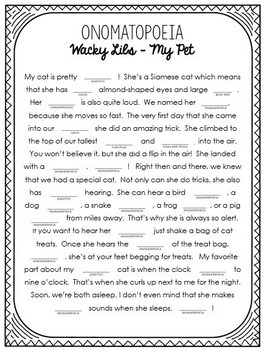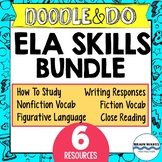Figurative Language Activities - ELA Doodle Notes and Learning Activities
- PDF
What educators are saying
Also included in
- Ready to instantly engage students with fun, doodle-y, and challenging English Language Arts lessons?Then, this bundle of Doodle and Do resources is perfect for your classroom! It’s filled with 6 different units that will help your students…Write Responses with Text-Based EvidenceLearn about and prPrice $22.39Original Price $32.20Save $9.81
Description
This Doodle and Do resource is designed to help students understand 8 types of figurative language. First, students will complete highly engaging Doodle Notes about each type of figurative language. They'll doodle and sketch their notes on 5 different engaging doodle note pages. Students will learn about each type, review examples, and create examples of their own. Next, they’ll complete a fun writing activity for each type of figurative language. They’ll create silly similes with spinners, make metaphor matches, assemble personification cubes, participate in an alliteration tongue twister challenge, give sentences a hyperbole makeover, fill in onomatopoeia Wacky Libs, match and doodle idioms, and play oxymoron bingo. This mini-unit is not only effective in helping students understand different types of figurative language, it’s also super engaging and fun!
This resource is completely customizable, too! First, the two types of doodle notes included (filled-in and guided notes versions) make it easy to differentiate instruction. Then, the six learning activities can be easily transformed into learning stations if you’d like. This way, you can create the very best learning experience for your students!
This 8-day unit is not only effective in helping students understand figurative language, it’s also incredibly engaging and fun!
Skills Developed:
Students will…
- Develop an understanding of figurative language, word relationships, and nuances in word meaning
- Explain the meaning and note effectiveness of similes, metaphors, hyperbole, personification, alliteration, onomatopoeia, idiom and oxymoron
- Interpret figures of speech
- Write creatively using figurative language in response to writing prompts
- Work collaboratively and imaginatively
About the “Doodle” Notes:
First, students will learn all about figurative language and similes, metaphors, personification, onomatopoeia, hyperbole, alliteration, idiom and oxymoron by completing a set of doodle notes. Doodle notes are color-it-in, fill-it-in, and doodle-encouraging note sheets. They’re not only visually engaging, they’re also effective in helping students increase their focus and ability to recall information. Plus…they’re really fun! In this resource, there are 2 options of Doodle Notes:
- Option 1: All the notes are filled in. With this option students will color, embellish, and add doodles to the notes as you review the information with the class.
- Option 2: Some of the notes are filled in and students need to fill in the remainder of the notes (like guided notes). Students will work to fill in the notes as you teach the content.
About the “Do” Activities
After students complete their Doodle Notes it’s time for them to “Do” some fun activities. The activities are designed around lessons to help students practice recognizing, creating, analyzing, and writing figurative language. There are six activities in all:
- Simile: Students will be creating fun similes during this activity. First, they’ll create similes with “simile spinners.” Then, they’ll respond to a writing prompt and include a simile in their response.
- Metaphor: Students will be creating metaphors during this activity. First, they’ll brainstorm ideas based on teacher clues. Then, they’ll match the ideas to create and write creative and unique metaphors.
- Personification: Students will be writing 6 personification sentences during this activity. First, they’ll brainstorm verbs. Then, they’ll combine the verbs with nouns that they brainstorm to create examples of personification.
- Onomatopoeia: Students will be practicing onomatopoeia as they complete a Mad-Libs-inspired activity.
- Alliteration: Students will be writing sentences filled with alliteration. Then, they’ll challenge a partner to read their alliteration sentences without making any mistakes (tongue-twister-style).
- Hyperbole: Students will be giving simple sentences a makeover with hyperbole. They’ll create an interactive shape and then write six examples. Then, they’ll select two examples of hyperbole to integrate into writing prompts.
- Idiom: First students will complete an idiom matching activity. Then, they'll get creative as the doodle the literal meaning of 4 different idioms.
- Oxymoron: Students will create 6 original oxymorons. Then, they'll put their knowledge to the test during a super fun game of Oxymoron Bingo!
Implementation Ideas:
- Easily turn the fun activities into learning stations!
- Teach as a figurative language unit – covering one type of figurative language a day!
- Break up and teach at different times throughout the year
- Combine with a poetry unit
This detailed “Doodle and Do” resource includes:
- A detailed teacher overview of the resource
- 7 detailed lesson plans: Figurative Language, Simile, Metaphor, Personification, Onomatopoeia, Alliteration, Hyperbole
- Doodle and Do cover page for students
- Set of Doodle Notes – all filled in (4 pages)
- Set of Doodle Notes – guided notes format (4 pages)
- Simile Spinners (2)
- Simile Writing Activity (2 pages)
- Metaphor Match-Up Activity (2 pages)
- Metaphor Match-Up Teacher Clues
- Personification noun and verb brainstorm
- Personification Cube template
- Onomatopoeia Wacky Libs – word clues
- Onomatopoeia Wacky Libs – “My Pet” passage
- Alliteration Challenge
- Hyperbole Makeover Interactive Shape
- Hyperbole Makeover Worksheet
- Hyperbole Writing
Other Doodle and Do Resources…
- Langston Hughes – Poet and Poem Study --- Doodle Article and Interactive Poetry Analysis Flip Book
- Maya Angelou – Poet and Poem Study --- Doodle Article and Interactive Poetry Analysis Flip Boo
- 5 Reading Skills Mini-Units
- 5 Nonfiction Text Structure Mini-Units
- How to Study for a Test Doodle Notes and 5 Learning Stations
- Writing Responses with Text-Based Evidence Doodle Notes and 5 Learning Stations
- Doodle Book Review Any book!
Or, you may also like…
- Figurative Language Unit
- 12 Writing Units Bundle - Writing instruction for an entire year!
- 101 Writing Prompts!
Have you seen these Creative Writing Videos?
Following is Fun!
Get the inside scoop on all store discounts, free products, and product launches. Just click the green “Follow Me” star under my store name on this page or click the green “Follow Me” star on my store homepage.
Let’s Stay in Touch!
*** Click HERE to receive the Brain Waves Instruction Newsletter filled with exclusive FREEBIES and Teaching Tips!
Thanks!
Brain Waves Instruction
Doodle notes is a trademarked term used with permission. Please visit doodlenotes.org for more information.






